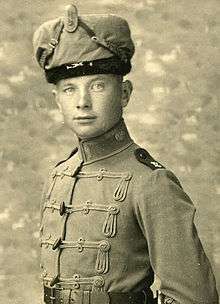Walter von Bülow-Bothkamp
Leutnant Walter von Bülow-Bothkamp (alternate spelling Bothcamp) (24 April 1894 – 6 January 1918), Pour le Merite, Military Order of Saint Henry, Iron Cross was a German fighter ace from an aristocratic family who was credited with 28 victories.
Walter von Bülow-Bothkamp | |
|---|---|
 Walter von Bülow-Bothkamp as Braunschweig Hussar in 1914 | |
| Born | 24 April 1894 Borby, Kingdom of Prussia |
| Died | 6 January 1918 (aged 23) near Ypres, Belgium |
| Buried | Family chateau |
| Allegiance | German Empire |
| Service/ | Hussars Regiment 17; Luftstreitkräfte |
| Years of service | 1914–1918 |
| Rank | Leutnant (Lieutenant) |
| Unit | Hussars Regiment 17, FA 22, FA 300, Jagdstaffel 18, Jagdstaffel 36, Jagdstaffel 2 |
| Commands held | Jagdstaffel 36, Jagdstaffel 2 |
| Awards | Pour le Merite, Military Order of Saint Henry, Iron Cross |
| Relations | Harry von Bülow-Bothkamp Konrad von Bülow-Bothkamp Frederick von Bülow-Bothkamp |
Early life
Walter von Bülow-Bothkamp was born at Borby, now a part of Eckernförde in Schleswig-Holstein, Germany.[1] He was the second eldest son in his family; there would be two younger brothers. All four of them would serve their country during World War I, with three of them dying in service.[2]
Bülow-Bothkamp graduated from the Baccalaureate High School in Plon, Schleswig-Holstein in 1912. He then traveled for six months in Great Britain and Switzerland. After his wanderjahr he settled in to study law at the University of Heidelberg. He also joined a student corps there.[2]
In August 1914, he and his younger brother Conrad joined Braunschweige Hussars Regiment 17 (the Deaths Head Hussars). In January 1915, he accompanied his unit to the front in southern Alsace.[2]
Early Flying Service
Walter von Bülow-Bothkamp was commissioned as a leutnant (lieutenant) in April 1915 and applied for pilot's training in the Luftstreitkräfte (German air service). Along with his brother Conrad, he trained in Replacement Division 5 in Hanover[2] from 15 April through 15 September 1915.
Bülow-Bothkamp was originally posted to FA 22, which was an aviation squadron organized for aerial reconnaissance, observation, and direction of artillery on the Western Front. Although flying an AEG G.II two-seated observation plane, he managed to down enemy two seaters on consecutive days, 10 and 11 October 1915.[3] He served with FA 22 until 14 March 1916.
After an award of the Iron Cross First Class[4] for his victories in October, his transfer to FA 300 took him to the Middle East to continue his reconnaissance duties in support of a German ally, the Ottoman Empire. He flew on the Palestinian front[3] and was wounded on 13 June 1916. In a letter home from the hospital in Jerusalem, he joked about his shoulder wound being as inconsequential as a dueling scar suffered at university.[2]
After his discharge from hospital on 1 July, he won twice more near El Arish, with a fifth victory unconfirmed.[1]
His courage and aggressiveness earned him a transfer to piloting fighter planes. He left FA 300 on 7 December 1916 and joined a Prussian fighter squadron, Jagdstaffel 18
Fighter Service
Bülow-Bothkamp shot down two enemy aircraft on 23 January 1917 and another the following day, to start his and Jasta 18's victory roll. By 10 May, when he transferred out of Jasta 18, his total stood at 13.[3]
Appointed to Leadership
He was then appointed Commanding Officer of Jagdstaffel 36. He promptly shot down two French observation balloons at Bouvancourt on 21 May. A hip wound kept him from scoring for a while, before he began a steady accumulation of triumphs that would extend from 6 July to 2 December. During this stretch, on 8 October, after 21 victories, he was awarded the highest decoration of both Prussia and the German Empire, the Pour le Merite.[3] On 29 October, he went on leave until 7 November, leaving Hans Hoyer in temporary command of the squadron.[5]
On 2 December, he killed Lieutenant Harry G. E. Luchford of No. 20 Squadron RAF when he shot down his Bristol F.2 Fighter. This was Bülow-Bothkamp's 28th and final victory.[3]
On 13 December 1917, he was transferred to being Commanding Officer of a more prestigious unit, Jagdstaffel 2, Oswald Boelcke's old unit. On 6 January 1918, Walter von Bülow-Bothkamp led his wingmen into a dogfight against No. 23 and No. 70 Squadrons of the Royal Flying Corps near Ypres. He did not survive. RFC aces Captain Frank G. Quigley and Captain William M. Fry are believed to be his conquerors.[3]
Walter was buried in his family chateau's cemetery. He joined his brother Frederick, killed in action in 1914. Within the year, Conrad would join them.[2]
Decorations and awards
- Iron Cross of 1914, 1st class (October 1915) and 2nd class (April 1915)
- Pour le Merite (8 October 1917)
- Knight's Cross of the Military Order of Saint Henry (posthumously, on 7 October 1918)
References
- Franks, Norman; Bailey, Frank W.; Guest, Russell. Above the Lines: The Aces and Fighter Units of the German Air Service, Naval Air Service and Flanders Marine Corps, 1914–1918. Grub Street, 1993. ISBN 0-948817-73-9, ISBN 978-0-948817-73-1.
- Franks, Norman (2004). Jasta Boelcke. London: Grub Street. ISBN 978-1-904010-76-0.
Endnotes
- The Aerodrome website page on Walter von Bülow-Bothkamp http://www.theaerodrome.com/aces/germany/bulow-bothkamp2.php
- frontflieger website page on Bülow-Bothkamp http://www.frontflieger.de/3buelow0t.html
- Franks et al 1993, p. 90.
- Note: German policy called for award of the Second Class as a prerequisite for the First Class award; therefore Bülow-Bothkamp had already won the Second Class Iron Cross.
- Franks et al 1993, p. 132.
External links
- http://www.theaerodrome.com/aces/germany/bulow-bothkamp2.php Accessed 18 October 2008.
- http://www.frontflieger.de/3buelow0t.html Accessed 18 October 2008. Translation via Google.
- de:Walter von Bülow-Bothkamp Accessed 18 October 2008. Translation via Google.
- http://www.theaerodrome.com/forum/2001/10155-eduard-von-schleich-walter-von-b-low-bothkamp.html Accessed 18 October 2008.
- http://www.sero-papermodels.com/content.do?object=jasta.jasta18&page=page.jasta Accessed 18 October 2008.
- http://www.pourlemerite.org/ Accessed 18 October 2008.